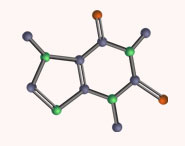


 علم الكيمياء
علم الكيمياء 
 الكيمياء التحليلية
الكيمياء التحليلية 
 الكيمياء الحياتية
الكيمياء الحياتية 
 الكيمياء العضوية
الكيمياء العضوية 
 الكيمياء الفيزيائية
الكيمياء الفيزيائية
 الكيمياء اللاعضوية
الكيمياء اللاعضوية 
 مواضيع اخرى في الكيمياء
مواضيع اخرى في الكيمياء
 الكيمياء الصناعية
الكيمياء الصناعية |
أقرأ أيضاً
التاريخ: 2024-04-21
التاريخ:
التاريخ: 21-11-2019
التاريخ: 10-3-2016
|
Butadiene has two π bonds, each made up of two p orbitals: a total of four atomic orbitals. We’d therefore expect four molecular orbitals, housing four electrons. Just like hexatriene above, these orbitals extend over the whole molecule, but we can easily work out what these molecular orbitals look like simply by taking the orbitals of two alkenes and interacting them side by side. We have two π orbitals and two π* orbitals, and we can interact them in phase or out of phase. Here are the fi rst two, made by interacting the two π orbitals:
We can represent all four molecular orbitals like this, stacked up in order of their energy in a molecular orbital energy level diagram. With four orbitals, we can’t just use ‘*’ to represent antibonding orbitals, so conventionally they are numbered ψ1–ψ4 (ψ is the Greek letter psi).
It’s worth noticing a couple of other things about the way we have represented these four molecular orbitals before we move on. Firstly, the number of nodes (changes in phase as you move from one orbital to the next) increases from zero in ψ1 to three in ψ4. Secondly, notice that the p orbitals making up the π system are not all shown as the same size—their coefficients vary according to the orbital they are in. This is a mathematical consequence of the way the orbitals sum together, and you need not be concerned with the details, just the general principle that ψ1 and ψ4 have the largest coefficients in the middle; ψ2 and ψ3 the largest coefficients at the ends. Now for the electrons: each orbital holds two electrons, so the four electrons in the π system go into orbitals ψ1 and ψ2.
A closer look at these fi lled orbitals shows that in ψ1, the lowest energy bonding orbital, the electrons are spread out over all four carbon atoms (above and below the plane) in one continuous orbital. There is bonding between all four C atoms—three net bonding interactions. ψ2 has bonding interactions between carbon atoms 1 and 2, and also between 3 and 4 but an antibonding interaction between carbons 2 and 3—in other words, 2 – 1 = 1 net bonding interaction. For the unoccupied orbitals there is a net –1 antibonding interaction in ψ3 and a net –3 antibonding interaction in ψ4. Overall, in both the occupied π orbitals there are electrons between carbons 1 and 2 and between 3 and 4, but the antibonding interaction between carbons 2 and 3 in ψ2 partially cancels out the bonding interaction in ψ1. Only ‘partially’, because the coefficients of the antibonding pair of orbitals in ψ2 are smaller than the coefficients of the bonding pair in ψ1. This explains why all the bonds in butadiene are not the same, and also why the middle bond is like a single bond but with a little bit of double-bond character. Its double-bond character extends to its preference for planarity, the fact that it takes more energy to rotate about this bond than about a typical single bond, and the fact that it is slightly shorter (1.45 Å) than a typical C–C single bond (around 1.54 Å).
The molecular orbital diagram also helps us explain some aspects of the reactivity of buta-diene. Notice that we have marked on for you the HOMO (ψ2) and the LUMO (ψ3). On either side you can see the equivalent HOMO (π orbital) and LUMO (π* orbital) for the isolated alkene (i.e. ethene). Some relevant features to note:
• The overall energy of the two-bonding butadiene molecular orbitals is lower than that of the two molecular orbitals for ethene. This means that conjugated butadiene is more thermodynamically stable than just two isolated double bonds. • The HOMO of butadiene is higher in energy than the HOMO for ethene. This is consistent with the fact that butadiene is more reactive than ethene towards electrophiles.
• The LUMO for butadiene is lower in energy than the LUMO for ethene. This is consistent with the fact that butadiene is more reactive than ethene towards nucleophiles. So, conjugation makes butadiene more stable, but it also makes it more reactive to both nucleophiles and electrophiles! This superficially surprising result is revisited in detail in Chapter 19.



|
|
|
|
حقن الذهب في العين.. تقنية جديدة للحفاظ على البصر ؟!
|
|
|
|
|
|
|
علي بابا تطلق نماذج "Qwen" الجديدة في أحدث اختراق صيني لمجال الذكاء الاصطناعي مفتوح المصدر
|
|
|
|
|
|
|
شعبة التوجيه الديني النسوي تقيم دورة تعليم مناسك الحج للوافدات إلى الديار المقدسة
|
|
|